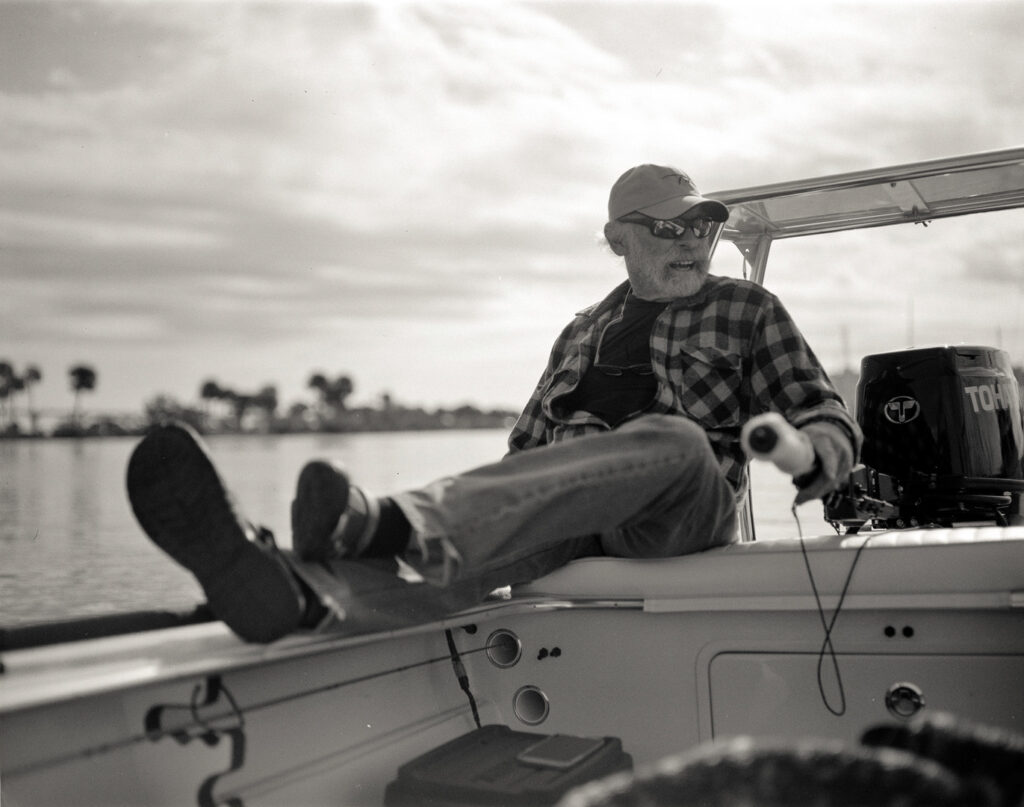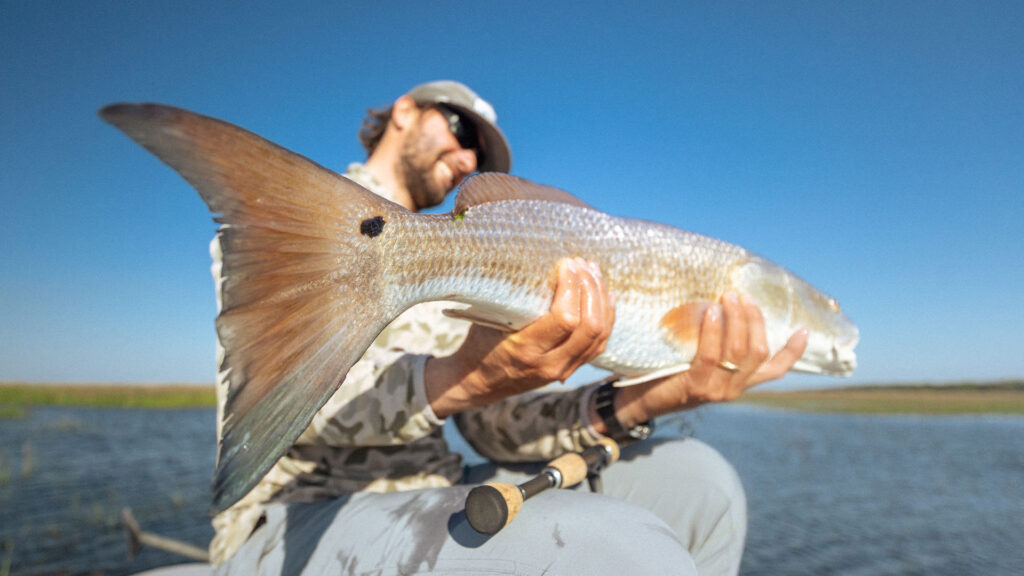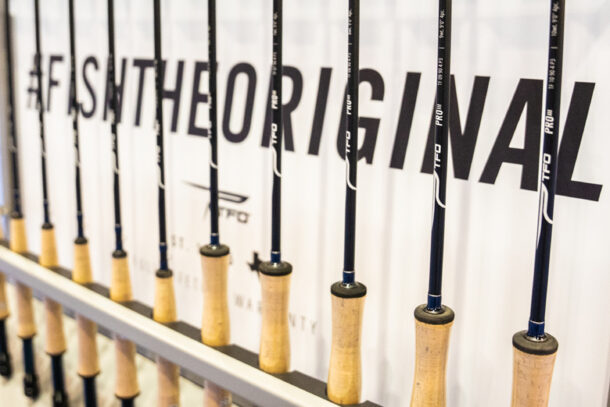For most anglers, fishing is just a hobby.
For guide and owner of Harcourt Fly Fishing 3G, Dustin Harcourt, it’s a lifelong family passion. The 3G specifically stands for three generations of Harcourt anglers – Dustin’s father, himself, and his son. Before fly shops became popular, and certainly before the internet and YouTube, Dustin and his Dad had to improvise to make the patterns that would work best for their Colorado rivers. Coming up with new patterns was a hobby and skill that Dustin, his son, and his 12-guide staff continue to work on to provide their clients with the best possible experience.
Its late summer in Colorado, and Dustin and his team are dialed into one of the most anticipated and well known “hatches” on local rivers – hopper fishing. This time of year, you can walk along a riverbank on the Colorado River and easily find pinky finger-sized grasshoppers. While these bugs might seem like a normal summer terrestrial to us, to trout and other species, this is a high protein meal that is simply irresistible.
This week, we checked in with Dustin after a day on the water to talk more about this popular style of western river fishing, and how he approaches it.
Tell us where you are guiding, some of the rivers you personally fish and what a typical day of fishing on these rivers entail (species, average size, etc).
We’re located near Glenwood Springs just outside of New Castle, Colorado. We have four all-star rivers here, which are the: the Frying Pan, Crystal, Roaring Fork and the Colorado River. I live about 3 miles from a boat ramp on the lower Colorado River, so I do a lot of guiding in that area. Not just for proximity, but for other important (and my favorite) factors: less crowds, bigger fish, and more fish.
The Colorado is primarily a trout river with species that include rainbows, browns, cutthroat, Sink River Cutthroat, and Colorado River cutthroat. The average size is 16 to 20-inches, but we get into 20 to 21-inch fish every other day.

A healthy Colorado rainbow caught by TFO Fly Fishing Category Manager Nick Conklin on the new Blue Ribbon while on a trip with Harcourt Fly Fishing 3G this summer. Photo Nick Conklin
For those unfamiliar, what is “hopper season”, what is a “hopper dropper rig” and when does it typically start and end in your area.
Hopper season refers to the emergence of grasshoppers along the banks of our many different rivers. High winds and other factors can push those hoppers to the water, making a very a high protein and irresistible meal for trout.
The season usually starts around mid-June after our mud season and the rivers start to clear. During this time, we have a really good stonefly hatch, and we have a lot of luck fishing with the chubby chernobyl patterns. This will last for about a month, then we start switching to hoppers in late July.
In July, we’ll start throwing smaller size 8 hopper imitation patterns. As the weather gets warmer throughout the summer, the hoppers tend to get bigger and abundant, we’ll switch to sizes 2 & 4. This happens around September/October, so very soon for us! As you walk through the bushes, you’ll see them all over. They can get as big as the size of your pinky finger. Typically, hopper season wraps up around November. After a couple of really heavy frosts or cold evenings, the hoppers will frost and disappear.
Hopper Dropper – The hopper dropper term refers to using a grasshopper imitation fly, with another fly tied below, (known as a dropper). Depending on the state you live in, you can use two additional flies below, (dropper) below a hopper pattern. Every state has different fishing regulations regarding how many flies or hooks you can us on a rig. Here in Colorado, we can use up to three flies per rig, but for a lot of other places it’s only two. Always check the regulations in an area before fishing somewhere for the first time.

A typical day on the Colorado River with Harcourt Fly Fishing 3G. Photo Dustin Harcourt
Do you find that all the trout species that inhabit your rivers have the same reaction/take to hoppers/grasshoppers? In other words, do big browns come up and hammer hoppers as well?
We can catch all trout species on hoppers, but it’s primarily cutthroat. They absolutely love grasshoppers. They’re more eager to come on up.
What is the “take” like? Is it similar to a dry fly take, or do they attack it like a streamer?
Right now, we’ve been noticing the bigger fish coming up really slowly and they’ll slowly open their mouth. You almost must wait for them to close their mouth, then set the hook. It’s difficult, especially for clients, because you see this big beautiful fish come up, but you just have to wait. It’s like a romance story (laughs).
What TFO rods do you like to use hopper or hopper dropper rigs? What is about these rods that work so well for this type of fishing?
Right now in the heart of August, we are throwing many different rigs. Everyday, I’ve got 6 rods on the boat: 4 in the rod holders, and two in the hands of clients. Each rod has a different setup and purpose to help us have the right tool for the right fishing scenario for that day.
Usually I’ve got a streamer setup, an adjustable nymphing rig combo, and then a hopper-dropper setup.
I absolutely love the new Blue Ribbon rods. I have a 10’ 4wt – which is an incredible hopper dropper rod. We’re on the boat quite a bit, so high sticking and light mending is crucial for keeping excess line off the water and to help with getting quick and tight hook sets. This particular rod is perfect for this scenario and a favorite for me. Even on a windy day, this rod just punches right through.
Another rod I’ve enjoyed for fishing hopper dropper rods, if it’s not too breezy, is the new 10’6” 3-weight Stealth. I’ve found that even when it is breezy, it’s not too overwhelming at all. It can easily pick those larger hopper patterns and just zap it to where I need it to go with no problem.
I use 9’6” 6wt LK Legacy for my streamer and hopper/streamer rig, but the new 9’0” Blue Ribbon or LK Legacy in 6-weight or 7-weight are perfect for this as well.

Photo: Oliver Sutro
Are you targeting primarily the banks and eddies, or do you also focus on main runs/currents?
When we are out with clients, most of the time we are using nymph rig setups. However, once we get to the top of a run where the first ripple drop shelf comes, the deep nymph rigs get put aside, and that’s where the hopper dropper comes in. In this type of water, a big fish isn’t going to need to exert a bunch of energy in a 1-3 feet run of water. It’s going to hammer that grasshopper imitation. Aside from that scenario, we are concentrating on the banks.
Another technique that I really enjoy doing is fishing a hopper to a Pat’s Rubber Leg, then to a Thin Mint – which is a small streamer. We fish this setup like a streamer, focusing primarily on the banks, then retrieving back to the boat. The small movement of the hopper created while stripping back (2 – 3 inch micro twitch retrieves) imitates that grasshopper struggling to get back to the bank or off that water, but also gets that Pat’s rubber leg nymph and streamer to move. This basically creates three different water column responses – so a fish is going to hit something.
For this time of year, what I’ve been finding is that after any rapid, you have the best chance at that first section of soft water. You have all the oxygen coming off the rapids, then that first section of soft water is a real deadly place for a fish to hunt. They’re essentially in the air conditioning system with the oxygen of all the waves and rapids, but they’re also getting first dibs for food. I’ve found so often that the biggest fish, or the alpha tends to hang out in this spot.
The further away you get from the rapids, your statistics for catching bigger fish go down. Sure you can catch fish in these sections, but your odds are much better fishing right after those rapids on the head of a run.

A healthy Colorado rainbow trout. Photo: Dustin Harcourt
Any recommendations on fly lines, leaders and tippet?
Fly Lines – For fly lines I go with the traditional weight forward WF floating line. I’ve been using Rio fly lines and been really happy with them, although I’ve heard great things about Scientific Anglers as well. I used to oversize the rods with one fly line size, but now I just go with the line size that applies to the rod size.
Leaders/Tippet – For the hopper/dropper rigs, usually I’m going with a short leader. I use 16-inches of 20lb test, and then I’ll have about 16-inches of 1x tippet to my first fly/hopper. Currently, in the middle of August, the fish are down deeper, so I’ll drop about 4 feet to my first dropper, and then another 20-inches below that to the next dropper. It’ seems like a lot, but it’s really a short leader with all that on there. Having this short leader that turns the flies over easily for my clients from a boat has worked really well.

Photo: Cameron Mosier
What are you some of your go-to hopper/dropper rigs and flies?
Being able to tie and use a hopper fly that is incredibly buoyant and can hold tungsten and split shot well is critical. There are tons of great grasshopper patterns on the market right now that you can purchase in fly shops, but we tie our own foam hopper patterns.
We have a lot of fun going by the days and what we feel works best and we’ve nicknamed them random things like the Steroid Hopper, the SUP (Stand Up Paddleboard). Basically, a lot of foam, and a lot of vision is what we go for.
We do a lot of chubby chernobyl variations. We were actually able to get our hands on 5mm foam – which is about 3x thicker than the foam that some of the shops use here. With that, these flies are incredibly buoyant and visible, and we also add in hunter orange yarn to assist with the visibility for both the clients and the guides. When the fish looks up, they don’t see the orange, they’ll just see the underbody.
Adjusting to the Elements – For this year, our rivers have gotten incredibly mossy with the drought we got. Therefore, we are snagging into moss a lot more, so we had to creative on how to deal with this. We put a small swivel below our bottom fly, and that swivels and rotates through the moss – not catching the moss but getting the fly down quickly and right in the fish’s zone. This setup has been a game changer for us, and we are running this same setup (swivel below the bottom fly) for our nymph rigs as well.

Dustin Harcourt making the most of hopper season. Photo: Dustin Harcourt
Nymphing Hoppers – A lot of the times, I’ll go back to the “old school” hoppers – let’s say, the Dave’s Hopper. This particular pattern is not made of foam and is a great sinking hopper pattern that imitates grasshoppers that have been blown into the water and are drowning. Fish can be lazy and might not want to come up to the surface, so having a sinking hopper pattern that gets down in the water column to the fish is a great setup to have. Usually behind that subsurface hopper, we’ll trail a red quill nymph or a baetis nymph as an attractor. Other attractor meaty patterns we use are the very popular Pat’s rubber leg nymph and of course the San Juan worm.
Hopper & Streamers – With our streamer rod setups, I use hoppers as well. In years past, we’d be throwing streamers, and we’d have a pinch on indicator right next to the fly line. The pinch on indicator helped with detecting strikes during those dark and cloudy streamer days, but we started noticing that fish were attacking and striking at the indicator very regularly.
That magic light bulb went off in my head and I decided to invent a hopper/streamer rig. One foot off of my fly line, I put a big grasshopper pattern, and then I put on my streamer six feet below it, then an additional streamer. Now we’re getting hits on the hopper as the streamer is being retrieved. The fish love the movement of that hopper.
And last words or recommendations for our readers?
Like many rivers, lakes and oceans – every year is different, and every day is different. Some years, like this year, we’ll have banner hopper years. Yesterday I had 30 hopper eats, but today we had 8. Both days similar conditions, but that’s just fishing, and why I love the challenge of being on the water and helping clients out. Always be willing to switch it up, and just remember to enjoy yourself!

Dustin Harcourt is a TFO Ambassador and owner of Harcourt Fly Fishing 3G. You can find out more about Dustin his guiding website, or find him on Facebook.
![]()







